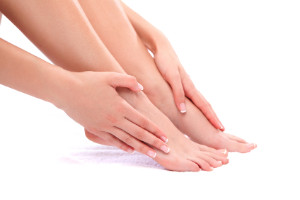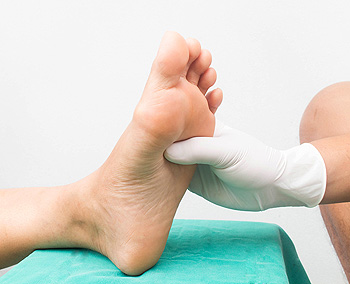
 The feet are the foundation of the body, and the health of your feet play an essential role in your overall well-being. Keeping the feet healthy is critical in maintaining an active lifestyle, so if foot ailments occur, it is advised to seek the medical attention of a podiatrist. These doctors specialize in treating all conditions concerning the foot, including injuries involving tendons and bones, issues caused by diabetes, and foot deformities. Other conditions that are typically treated by podiatrists are ingrown toenails, heel pain, and flat feet. When the disorder is diagnosed, proper treatment will be discussed for long term results, in addition to alleviating pain associated with the problem. Before your initial visit, you may want to comprise a list of concerns you have, as well as questions about the general health of your feet.
The feet are the foundation of the body, and the health of your feet play an essential role in your overall well-being. Keeping the feet healthy is critical in maintaining an active lifestyle, so if foot ailments occur, it is advised to seek the medical attention of a podiatrist. These doctors specialize in treating all conditions concerning the foot, including injuries involving tendons and bones, issues caused by diabetes, and foot deformities. Other conditions that are typically treated by podiatrists are ingrown toenails, heel pain, and flat feet. When the disorder is diagnosed, proper treatment will be discussed for long term results, in addition to alleviating pain associated with the problem. Before your initial visit, you may want to comprise a list of concerns you have, as well as questions about the general health of your feet.
If you are experiencing pain in the feet or s, don’t join the stubborn majority refusing treatment. Feel free to contact Dr. Robert Hope from Riverside Podiatry. Our doctor can provide the care you need to keep you pain-free and on your feet.
What Is a Podiatrist?
Someone would seek the care of a podiatrist if they have suffered a foot injury or have common foot ailments such as heal spurs, bunions, arch problems, deformities, ingrown toenails, corns, foot problems, etc.
Podiatric Treatment
A podiatrist will treat the problematic areas of the feet, or lower leg by prescribing the following:
A common podiatric procedure a podiatrist will use is a scanner or force plate which will allow the podiatrist to know the designs of orthotics. Patients are then told to follow a series of tasks to complete the treatment. The computer will scan the foot a see which areas show weight distribution and pressure points. The podiatrist will read the analysis and then determine which treatment plans are available.
If you have any questions please feel free to contact our office located in Tuscaloosa, and Fayette, AL . We offer the newest diagnostic and treatment technologies for all your foot needs.
Read more about What is a Podiatrist? One of the most important things diabetic patients can do is properly take care of their feet. This may prevent several foot related conditions from occurring, including foot ulcers; left untreated, foot ulcers can potentially lead to amputation. Loss of circulation in the legs and feet may happen as a result of nerve damage, also referred to as diabetic neuropathy. This condition can make the foot feel numb, making it difficult to feel any wounds or infections. Checking the feet daily is vital in maintaining proper foot care. This may include observing swelling, cuts, and changes in color occurring on the foot. Washing and drying the feet daily, in addition to trimming the toenails, are crucial steps to follow in protecting diabetic feet. When practicing a healthy lifestyle, foot complications may be prevented. A consultation with a podiatrist is advised if assistance is needed in maintaining proper foot care.
One of the most important things diabetic patients can do is properly take care of their feet. This may prevent several foot related conditions from occurring, including foot ulcers; left untreated, foot ulcers can potentially lead to amputation. Loss of circulation in the legs and feet may happen as a result of nerve damage, also referred to as diabetic neuropathy. This condition can make the foot feel numb, making it difficult to feel any wounds or infections. Checking the feet daily is vital in maintaining proper foot care. This may include observing swelling, cuts, and changes in color occurring on the foot. Washing and drying the feet daily, in addition to trimming the toenails, are crucial steps to follow in protecting diabetic feet. When practicing a healthy lifestyle, foot complications may be prevented. A consultation with a podiatrist is advised if assistance is needed in maintaining proper foot care.
Diabetic foot care is important in preventing foot ailments such as ulcers. If you are suffering from diabetes or have any other concerns about your feet, contact Dr. Robert Hope from Riverside Podiatry. Our doctor can provide the care you need to keep you pain-free and on your feet.
Diabetic Foot Care
Diabetes affects millions of people every year. The condition can damage blood vessels in many parts of the body, especially the feet. Because of this, taking care of your feet is essential if you have diabetes, and having a podiatrist help monitor your foot health is highly recommended.
The Importance of Caring for Your Feet
Patients with diabetes should have their doctor monitor their blood levels, as blood sugar levels play such a huge role in diabetic care. Monitoring these levels on a regular basis is highly advised.
It is always best to inform your healthcare professional of any concerns you may have regarding your feet, especially for diabetic patients. Early treatment and routine foot examinations are keys to maintaining proper health, especially because severe complications can arise if proper treatment is not applied.
If you have any questions please feel free to contact our office located in Tuscaloosa, and Fayette, AL . We offer the newest diagnostic and treatment technologies for all your foot needs.
Read more about How to Care for Diabetic Foot Many younger people who are physically active and engage in sports on regular basis often see inflammation in the sesamoid bones found under the toes This is referred to as sesamoiditis. This condition is considered to be a type of tendonitis, as the surrounding tendons become inflamed as well. Certain athletes and dancers may be afflicted by this often because additional weight is placed on the front of the foot. Common causes for this condition may include the sesamoid bones being involved in an injury, walking in shoes with thin soles, or wearing high heels. Inherited high arches that cause the foot to become stiff may be an additional cause. Possible treatments will likely include resting the foot, thus keeping it free from any weight bearing activities. Typically, wearing shoes with insoles that have adequate cushioning and support and choosing flat shoes instead of high heels are important choices to make if this condition is experienced. If you have pain in your foot you should make an appointment to see a podiatrist.
Many younger people who are physically active and engage in sports on regular basis often see inflammation in the sesamoid bones found under the toes This is referred to as sesamoiditis. This condition is considered to be a type of tendonitis, as the surrounding tendons become inflamed as well. Certain athletes and dancers may be afflicted by this often because additional weight is placed on the front of the foot. Common causes for this condition may include the sesamoid bones being involved in an injury, walking in shoes with thin soles, or wearing high heels. Inherited high arches that cause the foot to become stiff may be an additional cause. Possible treatments will likely include resting the foot, thus keeping it free from any weight bearing activities. Typically, wearing shoes with insoles that have adequate cushioning and support and choosing flat shoes instead of high heels are important choices to make if this condition is experienced. If you have pain in your foot you should make an appointment to see a podiatrist.
Sesamoiditis is an unpleasant foot condition characterized by pain in the balls of the feet. If you think you’re struggling with sesamoiditis, contact Dr. Robert Hope of Riverside Podiatry. Our doctor will treat your condition thoroughly and effectively.
Sesamoiditis
Sesamoiditis is a condition of the foot that affects the ball of the foot. It is more common in younger people than it is in older people. It can also occur with people who have begun a new exercise program, since their bodies are adjusting to the new physical regimen. Pain may also be caused by the inflammation of tendons surrounding the bones. It is important to seek treatment in its early stages because if you ignore the pain, this condition can lead to more serious problems such as severe irritation and bone fractures.
Causes of Sesamoiditis
Treatment for sesamoiditis is non-invasive and simple. Doctors may recommend a strict rest period where the patient forgoes most physical activity. This will help give the patient time to heal their feet through limited activity. For serious cases, it is best to speak with your doctor to determine a treatment option that will help your specific needs.
If you have any questions please feel free to contact our office located in Tuscaloosa, and Fayette, AL . We offer the newest diagnostic and treatment technologies for all your foot needs.
Read more about Sesamoiditis Obesity is a worldwide issue, affecting people from many different countries, and is often seen as a gateway for serious health conditions. The extra weight may cause imbalanced walking, consequently putting people at risk for falls and sprains or breaks. Some people experience swollen feet, often being a sign of circulatory problems, in addition to developing cracked heels, originating from additional pressure on the feet. Practicing proper foot hygiene is crucial for preventing many different kinds of foot disorders. Drying the skin between the toes is important, as this habit may prevent fungal infections from developing. Additionally, because some feet may be wider than average, it is critical to wear a well-fitted shoe. If you are experiencing health issues in your feet, a consultation with a podiatrist is advised for a diagnosis and treatment options.
Obesity is a worldwide issue, affecting people from many different countries, and is often seen as a gateway for serious health conditions. The extra weight may cause imbalanced walking, consequently putting people at risk for falls and sprains or breaks. Some people experience swollen feet, often being a sign of circulatory problems, in addition to developing cracked heels, originating from additional pressure on the feet. Practicing proper foot hygiene is crucial for preventing many different kinds of foot disorders. Drying the skin between the toes is important, as this habit may prevent fungal infections from developing. Additionally, because some feet may be wider than average, it is critical to wear a well-fitted shoe. If you are experiencing health issues in your feet, a consultation with a podiatrist is advised for a diagnosis and treatment options.
Obesity has become very problematic at this point in time and can have extremely negative effects on the feet. If you’re an obese individual and are concerned about your feet, contact Dr. Robert Hope from Riverside Podiatry. Our doctor can provide the care you need to keep you pain-free and on your feet.
Obesity and Your Feet
Since your feet are what support your entire weight when standing, any additional weight can result in pain and swelling. Being overweight is one of the main contributors to foot complications.
Problems & Complications
Extra Weight – Even putting on just a few extra pounds could create serious complications for your feet. As your weight increases, your balance and body will shift, creating new stresses on your feet. This uneven weight distribution can cause pain, even while doing the simplest tasks, such as walking.
Diabetes – People who are overweight are at serious risk of developing type-2 diabetes, which has a drastic impact on the health of your feet. As you get older, your diabetes might worsen, which could lead to loss of feeling in your feet, sores, and bruises. You could also become more prone to various infections.
Plantar fasciitis – Pressure and stress that is placed on muscles, joints, and tendons can trigger plantar fasciitis, which is an inflammation of tissue that forms along the bottom of the foot.
If you have any questions please feel free to contact our office located in Tuscaloosa, and Fayette, AL . We offer the newest diagnostic and treatment technologies for all your foot needs.
Read more about How Obesity Affects Your Feet Friction is generally the leading cause of blisters occurring on the feet. The majority of them are filled with a clear fluid; however, if an infection occurs, it may appear to have a yellowish hue. Typically, wearing ill-fitting shoes may cause friction on the skin, usually developing during repetitive motions like running and walking at moderate speeds. Some other causes of blisters may originate from severe burns or tissue damage caused by frostbite, while certain medical conditions including eczema can be linked to blisters on the feet. Treatment may include wearing shoes that fit comfortably without having the toes rub together. You can also apply a gauze pad for protection. If this option is chosen, infection may be avoided by changing the dressing regularly. Relief will be desired if extreme discomfort is experienced, and the blister may need to be drained. Please consider a consultation with a podiatrist for advice and recommendations for treatments of blisters.
Friction is generally the leading cause of blisters occurring on the feet. The majority of them are filled with a clear fluid; however, if an infection occurs, it may appear to have a yellowish hue. Typically, wearing ill-fitting shoes may cause friction on the skin, usually developing during repetitive motions like running and walking at moderate speeds. Some other causes of blisters may originate from severe burns or tissue damage caused by frostbite, while certain medical conditions including eczema can be linked to blisters on the feet. Treatment may include wearing shoes that fit comfortably without having the toes rub together. You can also apply a gauze pad for protection. If this option is chosen, infection may be avoided by changing the dressing regularly. Relief will be desired if extreme discomfort is experienced, and the blister may need to be drained. Please consider a consultation with a podiatrist for advice and recommendations for treatments of blisters.
Blisters are prone to making everyday activities extremely uncomfortable. If your feet are hurting, contact Dr. Robert Hope of Riverside Podiatry. Our doctor can provide the care you need to keep you pain-free and on your feet.
Foot Blisters
Foot blisters develop as a result of constantly wearing tight or ill-fitting footwear. This happens due to the constant rubbing from the shoe, which can often lead to pain.
What Are Foot Blisters?
A foot blister is a small fluid-filled pocket that forms on the upper-most layer of the skin. Blisters are filled with clear fluid and can lead to blood drainage or pus if the area becomes infected.
How Do Blisters Form?
Blisters on the feet are often the result of constant friction of skin and material, usually by shoe rubbing. Walking in sandals, boots, or shoes that don’t fit properly for long periods of time can result in a blister. Having consistent foot moisture and humidity can easily lead to blister formation.
Prevention & Treatment
It is important to properly care for the affected area in order to prevent infection and ease the pain. Do not lance the blister and use a Band-Aid to provide pain relief. Also, be sure to keep your feet dry and wear proper fitting shoes. If you see blood or pus in a blister, seek assistance from a podiatrist.
If you have any questions, please feel free to contact our office located in Tuscaloosa, and Fayette, AL . We offer the newest diagnostic and treatment technologies for all your foot care needs.
Read more about Blisters on the Feet